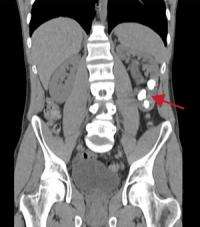Kidney stone mystery solved

Kidney stones strike an estimated 1 million Americans each year, and those who have experienced the excruciating pain say it is among the worst known to man (or woman).
Now, new research by scientists at Washington University School of Medicine in St. Louis provides evidence to explain why some people are more prone to develop the condition than others. Their discovery opens the door to finding effective drug treatments and a test that could assess a person's risk of kidney stones.
"Now, we finally have a more complete picture detailing why some people develop kidney stones and others do not," says senior author Jianghui Hou, PhD, assistant professor of medicine. "With this information, we can begin to think about better treatments and ways to determine a person's risk of the condition, which typically increases with age."
The research, in mice, is now available online in the EMBO Journal, published by the European Molecular Biology Organization.
Because kidneys function the same way in mice as in humans, the new findings can help scientists understand the root causes of kidney stones in patients. The mouse model used in the study can also serve as a platform for the preclinical testing of novel treatments for the condition, the researchers say.
Most kidney stones form when the urine becomes too concentrated, allowing minerals like calcium to crystallize and stick together. Diet plays a role in the condition — not drinking enough water or eating too much salt (which binds to calcium) also increases the risk of stones.
But genes are partly to blame. A common genetic variation in a gene called claudin-14 recently has been linked to a substantial increase in risk — roughly 65 percent — of getting kidney stones. In the new study, the researchers have shown how alterations in the gene's activity influence the development of stones.
Typically, the claudin-14 gene is not active in the kidney. The new research shows that its expression is dampened by two snippets of RNA, a sister molecule of DNA, that essentially silence the gene.
When claudin-14 is idled, the kidney's filtering system works like it's supposed to. Essential minerals in the blood like calcium and magnesium pass through the kidneys and are reabsorbed back into the blood, where they are transported to cells to carry out basic functions of life.
But when people eat a diet high in calcium or salt and don't drink enough water, the small RNA molecules release their hold on claudin 14. An increase in the gene's activity prevents calcium from re-entering the blood, the study shows.
Hou and his team have found that claudin-14 blocks calcium from entering passageways called tight junctions in cells that line the kidney and separate blood from urine.
Without a way back to the bloodstream, excess calcium goes into the urine. Too much calcium in the urine can lead to stones in the kidneys or bladder. Intense pain develops when a large stone gets stuck in the bladder, ureter or urethra and blocks the flow of urine.
Hou's research supports the theory that people with a common variation in claudin-14 lose the ability to regulate the gene's activity, increasing the risk of kidney stones.
He is optimistic, however, that drugs could be developed to target the short stretches of RNA that are intimately linked to claudin 14. Drugs that mimic these so-called microRNAs could keep the activity of claudin-14 in check and reduce the likelihood that stones would form.
Also, it may one day be possible to develop a diagnostic test to measure levels of the claudin-14 protein excreted in urine. Elevated levels would indicate an increased risk of stones, and people could take steps to prevent stones by modifying their diet.
"Many genes likely play a role in the formation of kidney stones," Hou says. "But this study gives us a better idea of the way one of the major players work. Now that we understand the physiology of the condition, we can start to think about better treatments or even ways to prevent stones from developing in the first place."
More information: Gong Y, Renigunta V, Himmerkus N, Zhang J, Renigunta A, Bleich M, Hou J. Claudin-14 regulates renal CA++ transport in response to CaSR signaling via a novel microRNA pathway. The EMBO Journal. Advance online publication Feb. 28, 2012.















